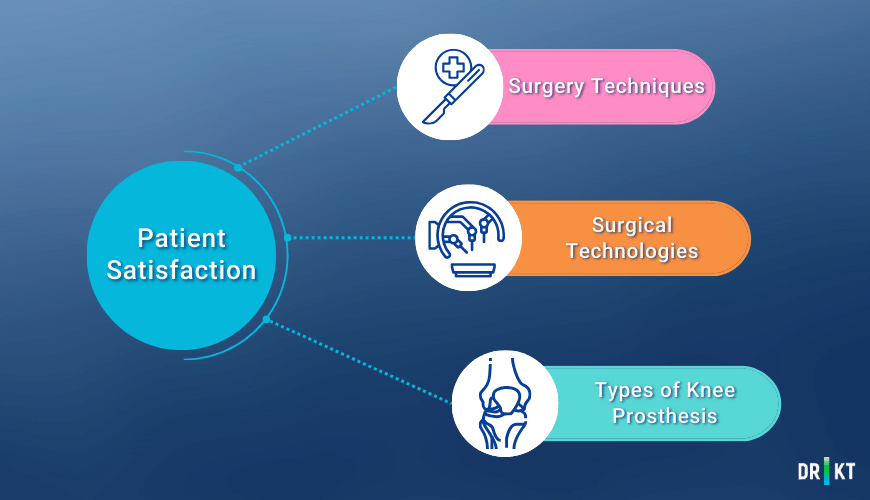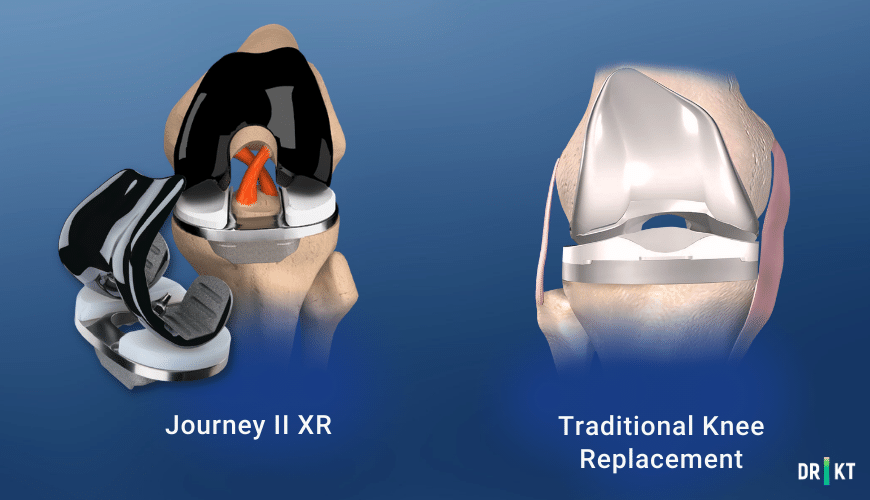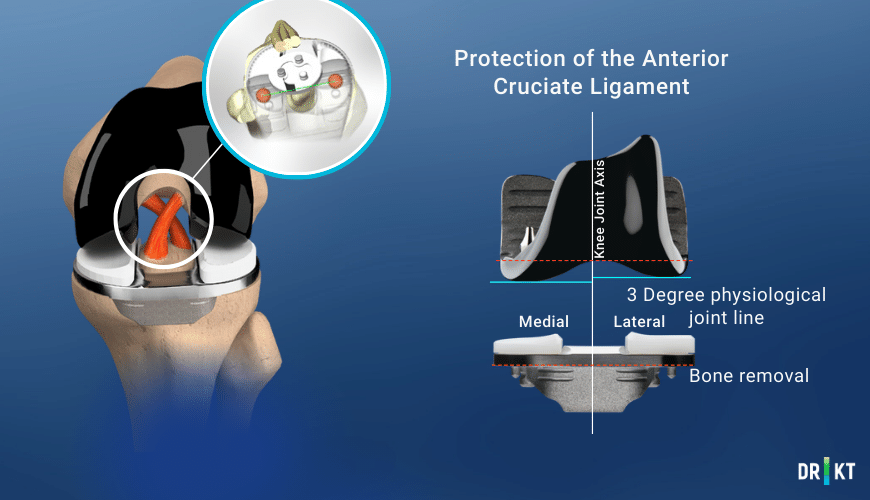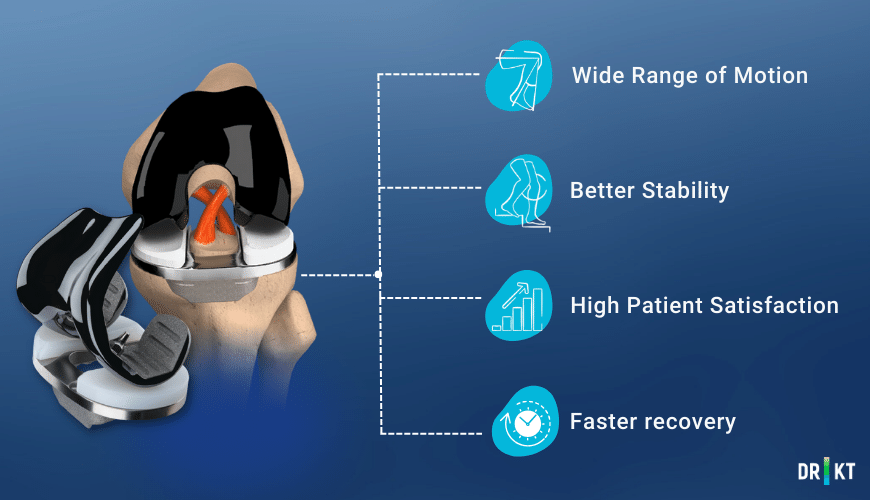
To lead an active life, it is important that our joints are healthy. However, advancing age, certain diseases or trauma can lead to various joint problems. The joint in our body where these problems are most common is our knees.
If these problems affecting the knee are not treated in a short time, arthritis develops in the knee joint. Knee arthritis is a condition that can occur spontaneously at an advanced age. In addition, knee arthritis can develop at a younger age as a result of certain sports injuries, accidents or illnesses. Knee osteoarthritis can lead to chronic pain and limited mobility.
Today, there are many treatment options for knee arthritis. However, knee replacement surgery may be necessary in the treatment of significant and severe knee arthritis. Knee replacement surgeries are performed as a permanent and definitive solution to relieve pain and restore the function of the knee.
However, innovations have been developed in many areas over time to achieve this goal and increase patient satisfaction. Today, patients have different options: The choice of technology (traditional/robotic), the choice of surgical technique (mechanical/kinematic) and the choice of knee replacement types are extremely important.
The most appropriate option is the one that meets the patient’s needs. For example, for patients who lead an active lifestyle, the Journey II XR knee replacement may be the best choice. The recently developed Journey II XR knee prosthesis has revolutionized knee prosthesis design with its similarity to the natural joint structure and its ability to protect the anterior and posterior cruciate ligaments.
Journey II XR knee prosthesis, which is known as the best knee prosthesis brand today, has now started to be used in knee surgeries in our country.
If you would like to learn more about all the features of the Journey II XR knee prosthesis, which protects the cruciate ligaments of the knee, and the advantages it offers to patients, you can find out more by reading the rest of our article.
Contents:
- How is Knee Replacement Surgery Performed? What are the Options?
- Best Knee Replacement Brand: Journey II XR Knee Replacement Protecting the Cruciate Ligaments
- Journey II XR Features
- Journey II XR Advantages
- Limitations of Journey II XR
- Who Can Journey II XR Be Applied To?
- To whom is Journey II XR not applicable?
- Operation Process
- Conclusion
How is Knee Replacement Surgery Performed? What are the options?
Knee replacement surgery is a surgical operation to restore the function of the knee joint damaged by arthritis, wear and tear or disease. The aim of the surgery is to relieve the pain caused by knee arthritis and to improve knee movement.
Expectations from knee replacement surgery may vary from person to person. For some patients, it may be enough to get rid of the pain and return to their daily life. Some people want to have a more active and mobile life by going to work, playing sports, dancing, gardening, etc. For this reason, the options in knee replacement surgery should be evaluated by considering the expectations of the patients and the decision should be made together with the patient.
The following three main factors should be taken into consideration when deciding on knee replacement surgery:
1- Surgery Techniques
Operative methods are divided into mechanical and kinematic. The mechanical method is a traditional approach used since the 1980s. The procedure is performed without taking into account the differences in the patients’ knees. However, everyone’s knee is different. There are even differences between our right and left knee.
The kinematic method is a relatively new approach, developed in 2006, based on this knowledge. The person’s own knee structure is taken into consideration when placing the prosthesis. More patient satisfaction is seen with the kinematic method.
2- Surgical Technologies
Knee replacement surgeries can be performed with traditional hand instruments or robotic surgery. Surgeons have been using traditional hand instruments since the 1970s to insert the knee prosthesis. Unfortunately, these hand tools have a sensitivity limit. So surgeons have a hard time getting the measurements they want.
Robotic knee replacement is a modern technology that enables the appropriate and accurate surgical procedure to be performed with 3-dimensional digital planning. The risk of technical errors is minimized in knee replacement surgeries performed under robotic surgical guidance. Thus, the surgical procedure can be performed with high precision and pinpoint accuracy.
3- Types of Knee Prosthesis
The knee prosthesis is very diverse in design and material. Therefore, many criteria should be considered when choosing a prosthesis. These criteria are: the design of the prosthesis, its functions, the materials used and its compatibility with the knee. For example, some of the metal materials used in knee replacements can enter the bloodstream as they wear and cause allergies. It is important to choose the most suitable prosthesis to avoid such incompatibilities.

All these factors are considered to influence patients’ satisfaction with the outcome after knee replacement surgery. For this reason, research and developments are being carried out to increase patient satisfaction. For example, recent developments in knee replacement design can be considered as a revolutionary solution and innovation in knee replacement surgeries.
Best Knee Prosthesis Brand: Journey II XR Knee Prosthesis Protecting Cruciate Ligaments

The role of the anterior and posterior cruciate ligaments in normal knee anatomy is to prevent the knee from becoming lax, to provide joint stability and to promote safety of movement.
However, in traditional knee replacement surgeries, one or both of the anterior and posterior cruciate ligaments in the knee must be cut to place the prosthesis in the knee. For this reason, after surgery, some patients may complain of not experiencing a natural and strong knee sensation when moving.
Recently, the Journey II XR knee replacement has been developed to address these problems, especially for those who want to return to an active and sporting lifestyle.
The Journey II XR knee prosthesis opens the door to a new era in knee prostheses by protecting the anterior and posterior cruciate ligaments in the normal structure of the knee.
The knee replacement surgery performed with Journey II XR is defined as “Bicruciate Retaining Knee Arthroplasty” in English. We can translate it into Turkish as “Cruciate Ligament Preserving Knee Prosthesis (BKDP) Journey II XR“.
This revolutionary prosthesis surgery aims to increase the post-operative satisfaction of patients with knee arthritis, accelerate the healing process and offer a more active life.
Designed especially for people who lead active lives or play sports, the Journey II XR may be the best choice for a knee replacement to protect the cruciate ligaments of the knee.
This prosthesis allows patients to feel their prosthetic knee as their own knee and allows them to move comfortably.
With the Journey II XR knee replacement, it is possible to perform at a higher level and lead a more active life with the protection of the cruciate ligaments. Therefore, the Journey II XR knee replacement is the best knee replacement brand.
Features of the Journey II XR Knee Replacement with Knee Ligament Protection
One of the most important factors affecting the success of knee replacement surgery is the type of prosthesis to be used. Every knee replacement design faces two major challenges. The first is that the implant can reproduce the normal movements of the natural knee. The second is to ensure joint stability after surgery.
To overcome these challenges, knee implant designs are constantly being developed and improved. The innovative JOURNEY II XR knee replacement is different from most other knee implants. Its aim is to help patients restore normal knee function, move without pain and lead a more active life.
The features of the Journey II XR knee prosthesis that protects the knee ligaments are as follows.
- Similarity to Natural Knee Anatomy: The BKDP Journey II XR knee replacement features an anatomically shaped femoral component that mimics the natural angles of the human leg. In this way, it can help the knee to return to its natural movements after surgery, without the need for the muscles and other soft tissues surrounding the knee to adapt to unfamiliar stresses.
- Design to Protect the Cruciate Ligaments: The JOURNEY II XR knee replacement uses a U-shaped tibial base plate that fits around the healthy anterior cruciate ligament (ACL) and posterior cruciate ligament (PCL). This protects these important ligaments during surgery. Knee joint stability is ensured and normal function is resumed.
- Material Used: The BKDP Journey II XR knee replacement is more durable because it is made using two special materials (OXINIUM metal alloy and high cross-linked plastic). OXINIUM metal alloy is twice as hard as the cobalt-chromium metal commonly used in dentures. As such, denture wear is 80% less common with JOURNEY II XR than with cobalt-chromium components. Another feature of the OXINIUM metal alloy is that it is free of risks such as metal allergies. Therefore, it is the most suitable and best knee replacement brand for patients with metal allergies and sensitivity.

Advantages of Knee Replacement (Journey II XR) Protecting the Cruciate Ligaments
The goal of prosthetic surgeries is to help patients regain normal knee function, allowing them to move without pain. The Journey II XR knee replacement, which protects the knee ligaments, offers many additional advantages thanks to its special design.
- Wide Range of Motion: After surgery, the knees have a wide range of motion. Patients can easily return to their daily lives and lead an active life.
- Faster Recovery: Faster recovery is seen after surgery compared to traditional prostheses. Muscles are in a stronger state. This makes it easier to move.
- High Patient Satisfaction: After knee replacement surgery with the BKDP Journey II knee prosthesis, natural knee motion and strong stability are achieved. In this way, the satisfaction of patients who gain more movement and activity ability than their expectations is high.
- Better Stability: Protection of the anterior and posterior cruciate ligaments provides greater stability in the knee. This means a more stable posture, good balance, comfortable walking and a high degree of safety for other physical activities.
- Long Lasting and Durable: The BKDP Journey II XR knee replacement is built to last. According to studies, it can be used for more than 20 years. This reduces the risk of revision surgery in the future.
- More Natural Movement: The Knee Ligament Protecting Knee Replacement (Journey II XR) preserves and improves people’s ability to move normally. The prosthesis design is structurally and functionally similar to the human knee, preserving both anterior and posterior cruciate ligaments; it provides a more natural movement in the knee, allowing patients to perform their daily activities and even some sports more comfortably.

Limitations of the Ligament Preserving Knee Replacement (Journey II XR)
Although the Journey II XR knee replacement has many advantages, it also has some limitations
- Surgical Challenges: The Journey II XR knee replacement is performed with a more complex surgical technique compared to other procedures. Therefore, orthopedic surgeons who will apply the prosthesis must undergo special training. Therefore, there are few centers and surgeons who can perform knee surgery with the Journey II XR, which protects the knee ligaments. So this service may not be available in every orthopedic clinic.
- Not Suitable for Everyone: The ligament-sparing Journey II XR knee replacement may not be a suitable option for every patient. In some cases, or for patients with certain health conditions, other methods may be required. It is important to consult with a qualified orthopedic surgeon to get the necessary information about the potential benefits and limitations of the Journey II XR knee replacement.
Who Can Receive the Journey II XR Ligament Preserving Knee Replacement?
The Journey II XR, a knee prosthesis that protects the cruciate ligaments, may be a prosthesis that many patients may want to choose. However, it is important to have certain health conditions to undergo surgery with this method. Otherwise it may be difficult to achieve the desired result. BKDP Journey II XR knee replacement is applicable in the following cases
- Patients with Advanced Osteoarthritis of the Knee: Osteoarthritis is a condition characterized by the wear of joint cartilage. This causes pain in the knee, stiffness and difficulty in movement. A ligament-sparing knee replacement helps to reduce pain and improve mobility in patients who have failed non-operative treatments. However, the BKDP Journey II XR knee replacement can only be used in patients with intact anterior and posterior cruciate ligaments.
- Patients Seeking More Natural Knee Movement: The Journey II XR knee replacement protects both the anterior and posterior cruciate ligaments, allowing for natural, balanced and safe knee movement. This is particularly important for patients who want to return to higher activity levels.
Who Cannot Have a Knee Replacement Journey II XR that Protects the Cruciate Ligaments?
On the other hand, the Journey II XR knee replacement, which protects the anterior and posterior cruciate ligaments, is not used in some cases. These situations are listed below:
- Patients with Severe Cruciate Ligament Injury: The aim of the BKDP Journey II XR knee prosthesis is to place the prosthesis in the knee without cutting the anterior and posterior cruciate ligaments in the knee joint. It is therefore not a suitable choice for patients with severely damaged or ruptured cruciate ligaments.
- Patients with inflammatory joint diseases such as rheumatoid arthritis: These diseases usually affect the entire joint. It can weaken the integrity of the cruciate ligaments in the knee. This reduces the chance of a BKDP Journey II XR knee replacement.
- Patients with Significant Angular Deformity of the Knee: The BKDP Journey II XR prosthesis is not applicable if the patient’s legs have developed significant deformities such as “braces leg” or “X leg” deformities. However, your orthopedic surgeon may recommend a BKDP Journey II XR knee replacement, depending on the overall condition of the knee.
- Patients with severe limitation of knee movement: Patients with knee arthritis usually experience pain and difficulty in movement. If the patient has difficulty bending and extending the knee, but can bend and extend it almost completely with someone’s help, there is no permanent limitation. In this case, knee replacement surgery that preserves the knee ligaments can be performed. However, if the doctor finds a limitation of more than 5-10 degrees in passive bending and straight extension of the knee during the examination, a permanent limitation has developed. In this case, the BKDP Journey II XR knee replacement is not recommended.
- Patients with previous knee replacement surgery: In these people, the anterior and posterior cruciate ligaments have already been cut. Therefore, when knee replacement revision surgery is required, there is no chance of a BKDP Journey II XR knee replacement.
If you are considering knee replacement surgery, you should discuss your personal health situation and the potential benefits and risks of the BKDP Journey II XR knee replacement with your orthopedic surgeon. After discussing this information, you and your orthopedic surgeon can decide on the best treatment option for you.

The Surgical Process of the Journey II XR Knee Replacement that Protects the Cruciate Ligaments
The Journey II XR knee prosthesis, which protects the ligaments in the treatment of knee arthritis, is as follows:
- Preoperative: Like all other surgical procedures, preoperative evaluation and preparation is performed. Patients’ general health status, activity levels in their daily lives and expectations from treatment are taken into account.
- Surgical Procedure: The surgery is usually performed under general anesthesia or spinal anesthesia and takes several hours. To insert the prosthesis in the knee, the orthopedic surgeon does not cut the anterior and posterior cruciate ligaments in the knee, but preserves them. The damaged joint is replaced with a BKDP Journey II XR knee replacement.
- After Knee Surgery: After surgery, patients are usually recommended a physical therapy and rehabilitation program. This allows the new knee to be moved correctly and patients to recover as quickly as possible.
- Conclusions: It was reported that most patients felt less pain and moved more easily after surgery. The BKDP Journey II XR knee replacement usually allows for a faster healing process. Patients can thus return to their active lives more quickly. However, it should be remembered that each patient’s situation is different and the healing process may vary from person to person.
- Risks and Complications: As with all surgical procedures, there are some risks associated with surgery with the BKDP Journey II XR knee replacement. Although the likelihood of complications is low, patients should be aware of these risks and get detailed information from their orthopedic doctor. Possible complications after surgery include infection, bleeding, stiffness, pain, nerve damage, wear or loosening of the prosthesis.
Conclusion
The Journey II XR, a cruciate ligament-sparing knee replacement, is a progressive approach to knee arthroplasty surgery that aims to give patients a more natural and active knee feel.
The BKDP Journey II XR knee replacement provides patients with a more natural and comfortable feeling of movement thanks to its similarity to normal knee structure and movement physiology. One of the biggest advantages is that both the anterior cruciate ligament and the posterior cruciate ligament are preserved. They are an important choice, especially for people with active lifestyles or who want to engage in physical activity.
However, this technique may not be suitable for everyone. Patients with osteoarthritis of the knee should seek the opinion of their orthopedic surgeon and consider the benefits and risks of the BKDP Journey II XR knee replacement when assessing whether they are a suitable candidate for the BKDP Journey II XR.
If you want to get more information about this knee replacement, you can contact us and ask what you are curious about.

